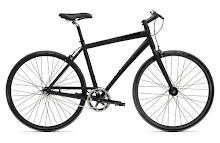Stay In Your Lane
On November 9th a letter-writer in the Amarillo Globe-News derided the city's new bike lanes as being "silly" and "too far out in the street." Furthermore, she questions the expense of installing them because "I haven't seen a single bike on them."
Sims' thinking reflects many misconceptions about bike lanes, which are a recent phenomenon in our city. Many residents probably do not have much experience cycling or driving in such systems, unless they have spent time in Denver, Portland OR, or Los Angeles. These cities have had extensive bike lane and path systems for many years, and motorists and cyclists alike are comfortable in their use.
I was a member of the Amarillo Hike & Bike Committee a couple of years ago. Our charge was to develop a master plan for cycling facilities in the city. To wit, we created a network of bicycle lanes and paths that we are now beginning to see laid across the city. When it is completed we will have about 90 miles of dedicated cycling facilities.
The lanes that Sims criticizes are indeed installed correctly. They are supposed to be adjacent to the lane(s) used by motor vehicles, and should only be near the curb when there is no parking lane. Compare, for example, the bike lane on Teckla Blvd. just north of 45th Ave., a section with no streetside parking. The bike lane is between the motor vehicle lane and the curb, as it should be located. But on Fulton Lane, the lane is sandwiched between a motor vehicle lane and a curbside parking lane. Again, this is as it should be located, because streetside parking is allowed on Fulton.
There is nothing inherently dangerous in riding in such a lane. The website BicyclingInfo.org contains a wealth of information about bike paths and lanes, and reports a study that shows that "...striped lanes encouraged safer behavior by cyclists. Cyclists using the roads with a striped bike lane were less likely to ride on the sidewalk, were less likely to ride against the flow of traffic and were more likely to obey stop signs and signals."
Notice that the lanes caused cyclists to operate their vehicles more safely. This is a direct benefit to motorists as well, because everyone is acting in a more predictable manner. Without lane markings of any kind (car or bike), a free for all ensues among users. The solid and dashed lines function to maintain order for all.
I have ridden extensively in many large cities across the US, and can vouch for the veracity of our bike lane system. In fact, Amarillo will be a premier city in the US when its bike lane system is complete. For a city of this size to have 90 miles of dedicated lanes is practically unheard of. We are in the process of transitioning from being hopelessly behind the rest of the nation, to being far ahead of the curve.
It takes forward thinking to implement such a system. Los Angeles, Portland, and Denver have had extensive bicycle facilties for many years. On a recent trip to Denver, I was able to cycle safely and quickly from the south side all the way downtown. In Los Angeles I have ridden for hours on bike lanes and paths that go to the ocean, Disney Land, and farther inland. Las Vegas is a recent addition to the ranks of bike-friendly cities. I spent several days there this fall on business and cycled daily on busy streets with bike lanes without ever leaving city limits.
Cities such as these are helping themselves by encouraging more people to ride their bikes to work and on errands, as well as for recreation. It's not just about sports and fitness, because the bike is also transportation. The advent of high gasoline prices is forcing us to reconsider the notion of a motor vehicle being a statement of our economic well-being. Cycling (or walking) are not just for people without the means to drive a car; saving money by using human transport just makes good sense.
Of greatest benefit to the city is the fact that our children will be able to cycle more safely to school. The network will link our schools by bike lanes, helping rid ourselves of unnecessary congestion at schools twice each day. The National Safe Routes to School Partnership has as its goal a nation in which children everywhere will be able to ride their bikes to school, thereby establishing healthy lifestyles at an early age. Never mind all the gas we'll save. Amarillo will be at the cutting edge of this movement when our network is complete.
It will take a little time as we ease into our new facilities. People can now rethink their transportation options and figure out how they could actually ride to work (and still take along the requisite wardrobe), or go shopping. As with all things new, there is a period of misunderstanding and questioning. To imply that the current lack of usage (from her perspective) suggests a failure and waste of money is not only premature, it is flawed. One would not tear up a road that has little or no traffic. Nor should bike lanes be scrapped.
I for one ride the bike lanes every time I cycle to Amarillo, which is several times each week. Knowing that I played a small part in helping design the network gives me great pride in our city and the leaders who saw fit to move Amarillo forward, not backward.
Dr. "Ride On" Gerlich


0 Comments:
Post a Comment
<< Home